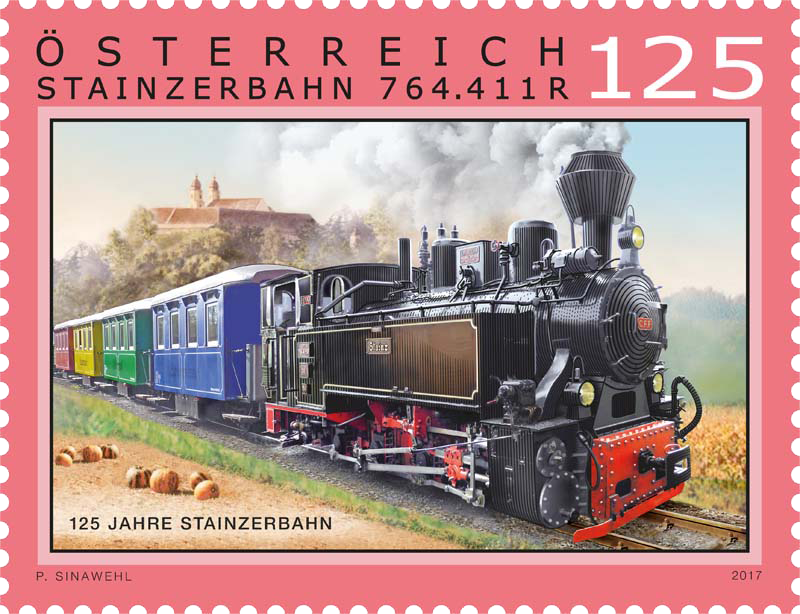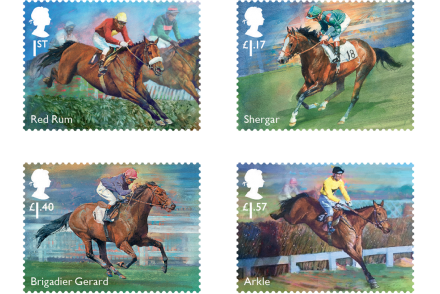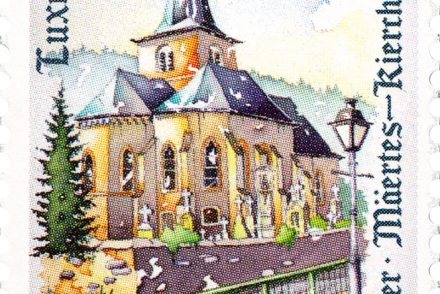125 Years of the Stainz Railway
Austria – With a track width of 760 millimetres, the “Bosnian-gauge”, the Stainz railways is classed as one of Austria’s narrow-gauge local railway lines. From 1892 on it covered the approximately 11.3 kilometre stretch between Preding and Stainz in western Styria. Austrian Post is celebrating this special anniversary with a commemorative stamp showing the “Flascherlzug (bottle train) with the picturesque Stainz Castle in the background.
The Stainz railway was opened on 26th November 1892, running from Preding-Wieselsdorf Station, where it connected with the Graz-Köllacher railway’s Wieserbahn, to Stainz. Until 1922 the railway was operated by Austrian Southern Railway, thereafter by the Styrian Provincial Railway Company. Passenger transport was halted in 1951, and in 1980, when the concession ran out, regular transportation of goods also came to an end. The engines and carriages were taken over for other routes covered by the Styrian Provincial Railway Company.
However, as long ago as 1971, railway enthusiasts organised a nostalgic steam train ride, which proved so successful that it became a permanent fixture. The so-called Stainz “bottle train” is now operated as a tourist attraction by the municipality of Stainz. The station buildings at Stainz and much of the track still date back to the founding of the Stainz railway.
The name bottle train dates from around 1920, at which time a miracle healer by the name of Johann Reinbacher, also known as “Höllerhansl”, was practising in Rachling bei Stainz. Most of his patients travelled to see him on the Stainz railway, which was not an easy journey, since his home was a good eight kilometres from the station. In their luggage they carried a urine-filled bottle, since it was claimed that Höllerhansl could diagnose his patients’ complaints from this and then treat them accordingly by means of herbal teas. The train thus has the patients to thank for its nickname of “bottle train”, whilst the return train to Preding-Wieselsdorf was affectionately known as the “tea train” – a reference to the herbal teas prescribed by Reinbacher. A song by Franz Moser dating from the year 1922 reminisces about the highly successful wonder healer, whose presence there also brought in profit to the municipality of Stainz.
Nowadays both a steam locomotive and a diesel engine are used for the Stainz bottle train, the latter as a reserve. The striking, colourful carriages also reflect the railway’s history, with the green carriage bearing the name Höllerhansl; the red carriage, the name Bergliesl (after a herbalist who worked for Höllerhansl) and the yellow one, Kräuterwagerl (little herb coach). The name of the blue buffet car draws less on historical than on gastronomic associations, with its name, Schilcherschaukel (Schilcher swing), obviously referencing the local wine. Other carriages can be added if needed. In addition to the nostalgic journey drawn by a steam locomotive, one can also enjoy music, hearty Styrian treats and, of course, the eponymous Schilcher wine on the train. A trip of this kind lasts a total of about two hours and is a delight which attracts around 20,000 railway enthusiasts to the region every year.
Issue Date: 28.05.2017
Designer: Peter Sinawehl
Printer: Joh. Enschedé Stamps B. V.
Process: Offset
Size: 42 x 32,25 mm
Values: 1.25€




